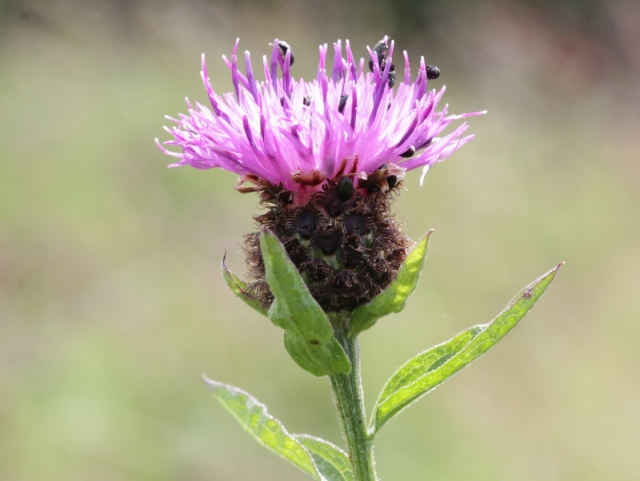
It would seem that knapweed is almost synonymous with meadow in conservation. If you want to create a new meadow then it’s in just about every meadow mix of seed you can find – always recommended as being good for bees and other pollinators, and even if you collect seed from an ancient meadow it’s likely to be in that. So much so, that one of the National Vegetation Classification types is even named after it – ‘MG5 Cynosurus cristatus – Centaurea nigra grassland’, or in common names/terms, ‘Lowland Meadow Crested dog’s-tail (a grass) – knapweed grassland’. Within this type of grassland (a national priority habitat) knapweed is pretty much a constant species…so wherever you stand in the meadow there’ll be some near you.
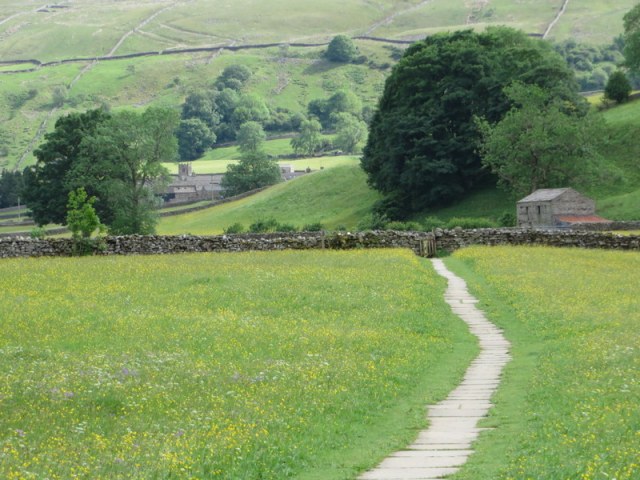
But the famous Muker meadows in Upper Swaledale have none, or at least very little of it, and as I visit regularly this has always a puzzle to me. Okay, so they are classed as a slightly different meadow type (an Upland Hay-meadow or MG3, which is found almost exclusively in the Yorkshire Dales) but a quick look at the BSBI species maps shows that knapweed grows along the dale so it’s not like the climate is wrong for it.
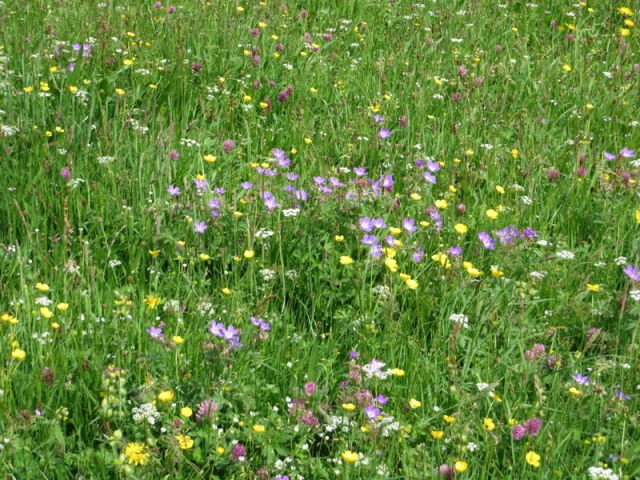
Perhaps it’s because the meadows are always cut around the middle of July to make hay and that’s when knapweed is just starting to flower in the north. If knapweed is cut before being able to set seed then over the years it will die out – makes sense, doesn’t it?
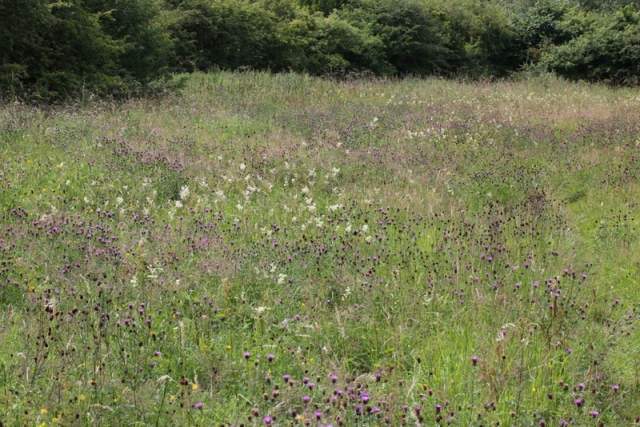
But hang on…surely everywhere else in the country must have made hay in June or July so why is knapweed just about everywhere else in meadows? And not just knapweed, but all the other mid/late-summer flowering wildflowers?
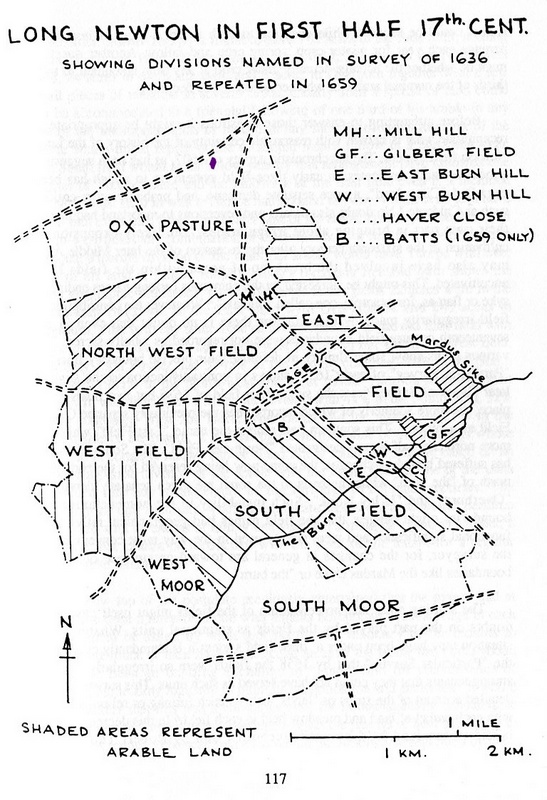
If we go back to our map of Long Newton in the mid Seventeenth Century and the survey of 1606 I think we get a clue. There was 10 times the amount of pasture to meadow (1121 acres pasture, 111 acres meadow) and we discover from a partial plan of c. 1616 that what there was of meadow at that time lay astride streams or damp ground or scattered through the arable fields in little patches (on the map designated ‘colcot’) with only a few larger areas subsequently divided into lots with different villagers owning different amounts.

There is no information in the documents on the grasses and wildflowers that made up the ‘colcot’ meadows and now with agricultural improvement and change of the last 350 years almost all the vegetation has changed completely…perhaps I need to mark out where I think the ‘colcot’ land is on a modern map and go and have a look just to check.

What of our knapweed? Well the biggest pieces of wildflower-rich grassland in Long Newton Parish would be the grazing land to the north and to the south, a pasture that was dotted with scattered gorse.
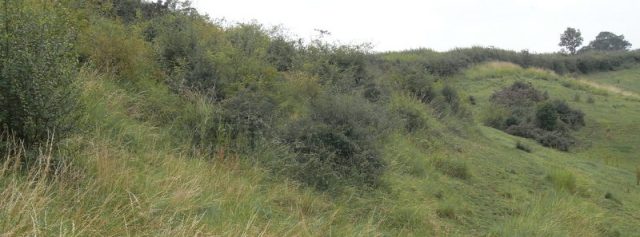
It seems sensible to assume it was the same in similar parishes throughout the country and that the later flowering grassland wildflowers like knapweed, along with the rarer saw-wort and betony, could evade hungry cow and sheep mouths often enough to flower and set seed, perhaps whilst growing amongst the gorse.
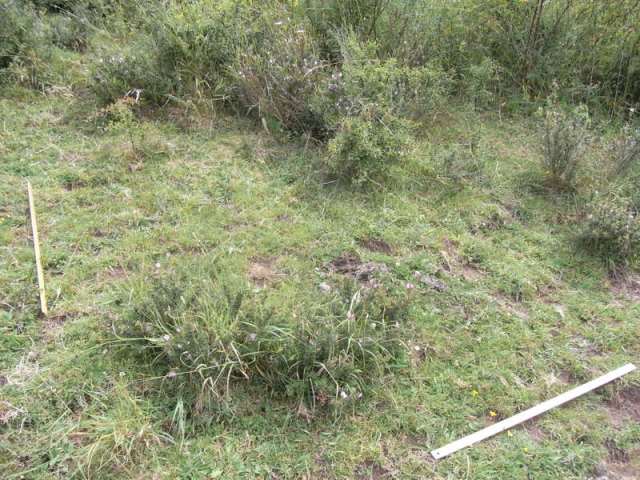
And then at the time of enclosure, when the wide open medieval fields were split and surrounded by hedges, maybe the farmer changed from grazing to hay-making and the knapweed hung on grimly growing, but not seeding, in the new regime it found itself in. Or maybe it seeded every 30 years or so in a wet year when the farmer was late cutting the hay or just maybe individual knapweed plants can live for hundreds of years under those conditions?
Blog on the need for an Ancient Grassland Inventory here
Medieval plant communities on road verges here
Notes.
Cutting your meadow and making hay in June or early July gives the best fodder for your cattle or sheep over the winter. Leave it later and it’s too chewy with less nutrients and the animals don’t like it as much. I’m using ‘meadow’ in its original meaning of ‘grassland which is mown for hay’
Plants with heavy seeds that can’t be windblown far, and the plant communities they grow in, don’t just appear by magic; they must have been influenced by or been derived from the farming that happened on the land before today, and in the UK we have at least 6-7000 years of that. Rackham has things to say about the relative amounts of pasture and meadow in England in his “The History of the Countryside” but that’s for another blog I think…
I dimly recall, from tweets on social media, that there’s an early flowering and a late flowering devil’s-bit scabious? Selective pressure of hay-making? Quick internet search and I couldn’t find anything so I may be mistaken, but I wonder if it is the case with other species? Early and late flowering forms of knapweed?
Back in 2004, I went to a day course ‘Bringing Back the Meadows’ by Flora Locale which demonstrated brush-harvesting and hand collection of seed (surprisingly quick if there are enough of you). I remember being told of a single farm (probably in the dales) where the fields near the farm were filled with early flowering grassland plants and those further away with later flowering wildflowers. The reason was to do with manpower…it takes quite a while to cut and collect/store a field of hay by hand; so, you cut the field nearest the farm first and gradually work outwards and over the years that is a selective pressure on the species that grow in each field. I’ve just looked to see if I can find my notes for the day…I did…early flowering plants often grow on shallow soils, later flowering plants on deeper richer soils…maybe just an additional factor to take into account. Flora Locale have a very good page on meadows https://www.floralocale.org/page24057 .
Why do the Muker meadows (MG3 community) have very little knapweed in them? No idea really…unless they were created from the start especially to be meadows and not derived from pasture vegetation already there. Was it those burly bearded Scandinavian Invaders who later decided to settle there who did it? I wonder…

I know a number of areas where there is the earlier flowering form of DBS. All hay meadows. In Oxon, Bucks and near me in Somerset. There’s also the curious distribution of rated and rayless knapweed …
Thank you Sue – I only know my area in the Tees Valley and we have, as far as I’m aware, only the later flowering versions of Devil’s-bit Scabious so it helps to know…and also that they are in hay meadows.
We don’t have the rayed form of knapweed up here (unless sown from a seed mix) so I didn’t even think of that! but it would be a straightforward one to research. It also brings to mind that when chalk knapweed is grown up here (again seed mix) it flowers at least a couple of weeks later than the local common knapweed.
I was visiting Wensleydale and Swaledale in July and noted how much bigger the Knapweed flower heads were, by comparison with the southern counties specimens which I am much more used to seeing… I did not really notice a south-north flowering season difference this year…
Wondering if there is a subspecies variant possibility?
Yes it’s entirely possible that knapweed is variable across the UK and it would be interesting to investigate. Also, if you live near light calcareous soil in the south then you may be seeing Chalk knapweed (Centaurea debeauxii) which is very similar but a slighter plant with more branched flower stems I think; there is even debate about whether it is a separate species or not…